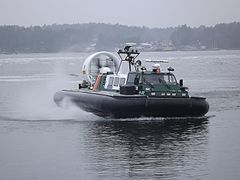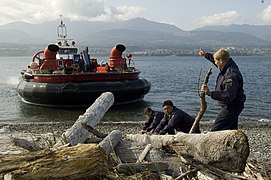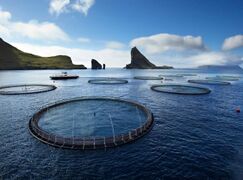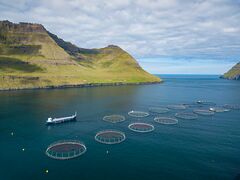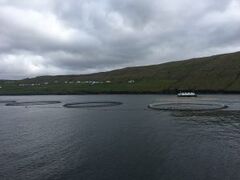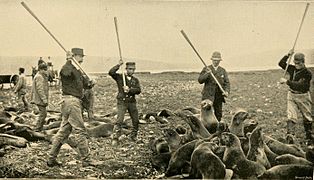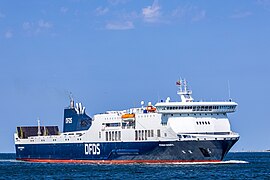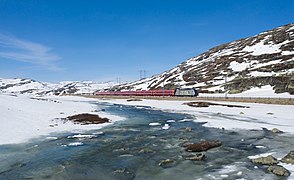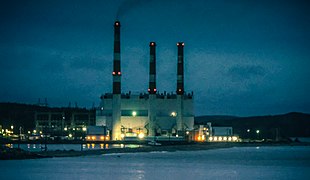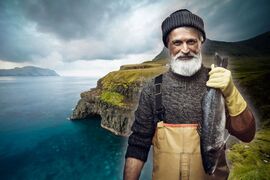Nauta Normand: Difference between revisions
m →Air Tag: 2017 source edit |
Tag: 2017 source edit |
||
| Line 381: | Line 381: | ||
====Natural Hazards==== | ====Natural Hazards==== | ||
*{{wpl|Frost quake}} | *{{wpl|Frost quake}} | ||
==Society== | |||
{{Template:Culture_in_Burgundie}} | |||
{{Pie chart | |||
| radius = 100 | |||
| thumb =right | |||
| caption = Self-reported ethnic origin in Placename ([[2035]]) | |||
| other = | |||
| label1 = [[Bergendii]] | |||
| value1 =40 | |||
| color1 =#4169E1 | |||
| label2 = {{wp|Corsican people|Ventan}}, | |||
| value2 =12 | |||
| color2 =#800080 | |||
| label3 = [[Sinitalian]] | |||
| value3 =9 | |||
| color3 =#9400D3 | |||
| label4 = [[Audonia]] (primarily [[Ebidi]]) | |||
| value4 = 8 | |||
| color4 =#4F7942 | |||
| label5 = other/multi-ethnic | |||
| value5 =31 | |||
| color5 =Blue | |||
}} | |||
<gallery mode="packed"> | |||
</gallery> | |||
Religion, ethnicity, language, education, attitudes and worldview, kinship and family, cuisine, arts, literature, architecture, sports, symbols | |||
==Economy== | ==Economy== | ||
Revision as of 13:10, 13 June 2024
Script error: The module returned a nil value. It is supposed to return an export table.
Nauta Normand | |
|---|---|
Province of Burgundie | |
| Nickname(s): The Northern Sailor, Hyperborea | |
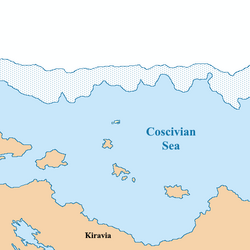 Map of Nauta Normand | |
| Nation | |
| Constituent Country | Burgoignesc Overseas Territory Assembly |
| Geographic designation | Polar Burgundies |
| Capital City | Soix |
| Area | |
| • Total | 854.696 km2 (330.000 sq mi) |
| Population | |
| • Total | 142,960 |
| • Density | 170/km2 (430/sq mi) |
| Demonym | Normandiennes |
| Website | www.burgundie.gouv/nautanormand |
Nauta Normand is an over-seas province of Burgundie located in the eastern Coscivian Sea. It shares a maritime border with Kiravia to the south. It is part of Burgundie's Burgoignesc Overseas Territory Assembly's Polar Burgundies geographic designation. It is home to 142,960 Normandiennes. It's capital and largest city is Soix which also serves as the province's largest port facility.
Nauta Normand is known for its hard-nosed residents who brace the elements every day to live on the desolate and barren landscape. It is however a critical naval and scientific outpost for Burgundie which are the two largest sectors of the economy. Because of the focus on science, the Normandiennes are incredibly well educated and their Internet speeds are fastest in Burgundie, averaging around 3gigs. The Normandiennes are predominantly focused on traditional lives fishing, herding, weaving, and what little agriculture can be eeked out, but the youth are preferring to go to Kiravia and the Burgoignesc Metropole in greater and greater numbers. To make up for this, larger and larger numbers of immigrants are being given incentives to move to Nauta Normand to maintain these cottage industries which is being met with mixed reactions from the locals.
History
Nauta Normand has been a seasonal fishing, sealing, and whaling station for Coscivians for centuries. It was not permanently settled until the Burgoignesc arrived in the 1700s. For the first half century the Coscivians and whalers from the Duchy of Martilles co-habitated the island during the various whaling, fishing, and sealing seasons. In the summer of 1748 the Duchy of Martilles set charged the Martillien North Levantine Trading Company (MNLTC) to establish a year-round presence on the island. Harsh winter conditions killed or forced the retreat of the first three expeditions. However, in 1753 the Martilliens were able to survive the winter and established the Nauta Normand colony in the modern capital, Soix. The colony was administered by the MNLTC for the next 123 years. During that time there were numerous small clashes with Kiravia as part of the Kiro-Burgoignesc Wars but none that caused the island’s sovereignty to come into question. It was dying this period that Nauta Normand became a vital whale oil and ice supplier for first the Duchy of Martilles and then the unified Burgundie. The island was joined into Burgundie as a province in 1876 and organized under BORA in 1908 when that was established.
During the First Great War the island was blockaded by the Kiravian Littoral Force until Burgundie signed an agreement to abstain from stationing military forces on the island. The island was left along for the rest of the war with the exception of Kiravian inspectors who were allowed to visit the islands to ensure that Burgundie was keeping it's word.
At the outbreak of hostilities of the Second Great War, Burgundie reached out to Kiravia and offered to demilitarize Nauta Normand in exchange for a guarantee of Burgoignesc sovereignty. Kiravia agreed but did station a patrol boat off the port of Soix for the whole of the war to indicate that Kiravia could enforce a blockage if they so chose.
During the latter half of the 20th century Nauta Normand's primary exports whale oil and ice were outpaced by technology, the island slipped into decline and it was considered to sell the island to Kiravia in the 1970s. However, with hundreds of thousands of veterans returning to the workforce in the waning years of Operation Kipling the solitude of Nauta Normand appealed to many veterans who were having trouble adapting to hyper-urbanized civilian life. 25,748 veterans eventually moved to Nauta Normand between 1973 and 1994 and they readily adopted to the simpler life of the Normandiennes. Today, the children and grandchildren of these veterans make up the majority of the Normandienne population. The island is sometimes referred to as the last ancient veterans coloniæ.
In the 21st century the island has seen an increasing decline in population as young people are moving to Kiravia and the Burgoignesc Metropole. Immigrants and their families are being incentivised to move to Nauta Normand to keep the cottage industries going. This has led to a resurgence of the economy and economic investment by the central government.
Politics and government
Nauta Normand is part of the Burgoignesc Overseas Territory Assembly's Polar Burgundies geographic designation. Burgoignesc Overseas Territory Assembly is a constituent country equivalent of Burgundie with its own assembly, prime minister, budget, and laws. Burgundie's national governmental influence is limited to subsidies, education, and security, however, its financial and cultural institutes cast a long shadow across Nauta Normand.
Nauta Normand is a province within Burgoignesc Overseas Territory Assembly with its own semi-elected Governor-Epistates, representative legislative body, and court system.
Nauta Normands are Burgoigniacs/Burgoignix with complete civil and economic rights, and citizenship (political rights) under the same federal service criteria as all residents of Burgundie. Burgoignesc is the official language but Coscivian and Burgoignesc are both in use.
Provincial executive
The provincial executive is the Governor-Epistates. Three candidates are elected by a single transferable vote election held every 5 years, the three candidates are presented to the Court of St. Alphador and the next Governor-Epistates is chosen from these candidates. If the citizenry rejects the selection, a run-off election is held with the remaining two candidates.
Provincial legislature
Like the Citizens Court of the National Assembly (Burg. La Assemblee de Ciutadans de l'Assemblee Nacional, ACAN), The Nauta Normand Citizen's Court of the Provincial Assembly is a unicameral legislator. It makes provincial law, has the power of the provincial purse, and has the power of impeachment, by which it can remove sitting members of the provincial government. The Assembly has three seats for each province, one for the Burgoignesc Overseas Territory Assembly's Nauta Normand liaison, 3 for the clergy, 3 seats reserved for municipal leaders, and 3 for a rota of private business leaders. On 6 occasions throughout the year 3 more seats are opened to the public to debate topics that are not on the annual legislative agenda.
Administrative divisions and local governance
Military
| St. Devereaux Naval Station Coscivian Sea Joint Maritime Patrol Station | |
|---|---|
| Near Soix in | |
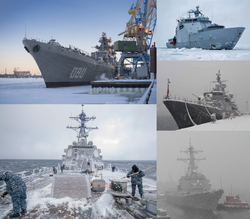 | |
| Site information | |
| Owner | Burgoignesc Security Forces |
| Operator | Navy of Burgundie |
| Condition | Operational |
| Garrison information | |
| Occupants |
|
Nauta Normand falls under the Navy's Kilikas Command, the Army's Boreal Command, the Royal Air Service of Burgundie's Boreal Command, and the Vocivine National of Burgundie's Coscivian Sea Command. The Navy_of_Burgundie and the Vocivine are the only services that maintain a permanent presence on the island. The fleet ships of the Navy and submarines of the Vocivine are stationed at St. Devereaux Naval Station. Some elements of Battle Squadron North Star and Sustainment Group Tundra Timber are permanently stations in St. Devereaux. The Boreal icebreaker fleet is also stationed at St. Devereaux Naval Station. 8 icebreakers are stationed here, and they are used to conduct sovereignty patrols but also to clear the shipping lanes for cargo ships coming to and from Port Soix.
Every able-bodied resident of Nauta Normand, over 18 and under 65, is conscripted into the Normandienne Fencible Regiment of Marine Infantry (Burg:'Regiment Fencible du Normandiennes d'Infantrie Marine (RFNIM)) of the Navy of Burgundie which requires that the citizens act as a ready reserve force, ensuring that the Army of Burgundie does not have to maintain a garrison on the islands. The RFNIM is also a functional universal basic income to support the population as the economy is shrinking the youth are moving to Kiravia or the Burgoignesc Metropole.
Emergency response and healthcare
-
Ambulance hovercraft
Law enforcement
The three national-level law enforcement agencies are all present on Nauta Normand, however, they have a comparatively small presence. To keep the local economy stimulated the Police Joint-Forces Boreal Training School is in Nauta Normand which serves the Gendarmerie, the Constabulary, and the Revenue Guard. This school is designed to teach survival, tracking, riot control, simple boreal combat maneuvers, and cultural accessibility training for arctic deployments. The
National Gendarmerie
Nauta Normand is under the jurisdiction of the Nauta Normand Battalion of the Borealis Brigade of the Overseas Gendarmerie Division. The Nauta Normand Battalion has 3 companies and an HQ section.
- A Company is assigned to Nauta Normand with a specific mandate to protect the capital Soix and the Port of Soix.
- B Company is assigned to the remainder of the islands. They are based in Vollande, on l'Ile de Brume.
- C Company is assigned to security for the Port of Soix and the Noralea Pier.
- The HQ section is also based in Soix.
Each company are equipped with both trucks and hovercraft to brave the snow in the winter in the event of an eminent threat. They are also useful to support local emergency response, including search and rescue, medivac, evacuation, extraction.
National Constabulary
Nauta Normand is under the jurisdiction of the Nauta Normand Battalion of the Borealis Brigade of the Overseas Constabulary Division. The Nauta Normand Battalion has 2 companies and an HQ section.
- A Company is assigned to Nauta Normand.
- B Company is assigned to the remainder of the islands. They are based in Rettaque, on l'Ile Marianne.
- The HQ section is based in Soix and shares a headquarters with the Gendarmerie.
Revenue Guard
Revenue Guard, Metaborealis Station is co-located in St. Devereaux Naval Station. It consists of the 7th Cutter Pod and the Burgo-Kiravian Joint Life Saving Squadron. The 33rd is equipped both rescue cutters and hovercraft. In the winter with medivac via helicopter is impossible, they work with local ambulance dispatch to cross terrain more quickly and to medivac people to the appropriate level of care.
Healthcare
Nauta Normand is serviced by 10 clinics, 6 pharmacies, 1 surgery, and one level III hospital. Those needed a higher level of care are airlifted to Kiravia where a reciprocal agreement allows islanders to receive care in Kiravia at the Government of Burgundie's expense.
Geography
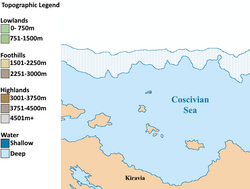
Nauta Normand consists of 4 islands, Nauta Normand being the largest, the two to the southeast are called The Little Twins (Burg: Les Petites Jumelles), and the larger island to the southwest is called Ile of Mist (Burg: l'Ile de Brume).
Nauta Normand is 699.297 square kilometers is mostly coastal plain in the north with a small rising plateau along the southern coast. Les Petites Jumelles, approxiamtely 32km off of the southeast, are 25.9 sqkm (Clarabelle) and 51.7 sqkm (Islebelle), separated from each other by a channel about 16km wide. L'Ile de Brume, 40km southwest of Nauta Normand, is 103.6sqkm.
Climate and environment
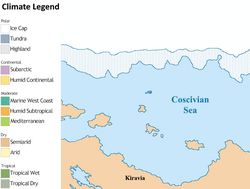
Nauta Normand has a polar climate.
| Climate data for 1981–2010 normals | |||||||||||||
|---|---|---|---|---|---|---|---|---|---|---|---|---|---|
| Month | Jan | Feb | Mar | Apr | May | Jun | Jul | Aug | Sep | Oct | Nov | Dec | Year |
| Average high °C (°F) | −13.5 (7.7) |
−13.0 (8.6) |
−7.5 (18.5) |
0.0 (32.0) |
5.6 (42.1) |
11.0 (51.8) |
14.9 (58.8) |
15.8 (60.4) |
11.5 (52.7) |
5.1 (41.2) |
−1.3 (29.7) |
−8.1 (17.4) |
−1.7 (28.9) |
| Daily mean °C (°F) | −17.6 (0.3) |
−17.4 (0.7) |
−12.5 (9.5) |
−4.6 (23.7) |
1.5 (34.7) |
6.4 (43.5) |
10.1 (50.2) |
11.0 (51.8) |
7.5 (45.5) |
2.1 (35.8) |
−4.4 (24.1) |
−11.8 (10.8) |
−2.5 (27.5) |
| Average low °C (°F) | −21.6 (−6.9) |
−21.8 (−7.2) |
−17.4 (0.7) |
−9.1 (15.6) |
−2.5 (27.5) |
1.8 (35.2) |
5.3 (41.5) |
6.1 (43.0) |
3.4 (38.1) |
−1.0 (30.2) |
−7.5 (18.5) |
−15.4 (4.3) |
−6.6 (20.1) |
| Average precipitation mm (inches) | 14.1 (0.56) |
12.0 (0.47) |
13.1 (0.52) |
13.7 (0.54) |
13.0 (0.51) |
15.0 (0.59) |
16.0 (0.63) |
15.4 (0.61) |
15.4 (0.61) |
14.6 (0.57) |
13.8 (0.54) |
14.1 (0.56) |
170.2 (6.71) |
| Average rainy days (≥ 1.0 mm) | 1.82 | 1.73 | 2.55 | 2.91 | 3.18 | 2.73 | 3.82 | 3.45 | 3.27 | 2.36 | 3.09 | 2.55 | 2.79 |
| Average relative humidity (%) | 84.43 | 83.73 | 84.33 | 83.58 | 81.11 | 77.57 | 79.02 | 79.35 | 75.29 | 75.24 | 82.63 | 84.49 | 80.9 |
| Mean monthly sunshine hours | 3.78 | 6.88 | 8.37 | 10.62 | 13.9 | 14.96 | 14.96 | 12.33 | 8.99 | 7.21 | 4.94 | 3.68 | 9.22 |
| Source: ur mum | |||||||||||||
Natural Hazards
Society
| This article is part of a series on the |
| Culture in Burgundie |
|---|
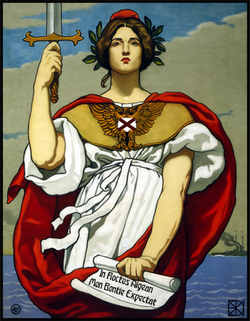 |
| Society |
| Arts and literature |
| Other |
|
Burgundie portal |
Religion, ethnicity, language, education, attitudes and worldview, kinship and family, cuisine, arts, literature, architecture, sports, symbols
Economy
-
Sheep herding is a major economic driver
-
So is cattle herding, Hamish here is adorable
-
Ship yard for the fishing fleet
-
Ferries to Kirav
-
Whaling fleet
Standard of living
Employment
Because Nauta Normand's economy is a high-low mix of sectors from research to traditional fishing and herding, opportunities abound for Normandiennes at all skill and education levels, which has helped the islands maintain a fairly steady unemployment rate of around X% for the last decade. Burgundie's high emphasis on education translates to a particularly educated and skilled workforce, leading to lower unemployment compared to less educated countries in Kiro-Borealis. The islands' economic diversity cushions against overreliance on any single industry, which has demonstrably made the island more resilient during downturns. Since Burgundie strives for Total Economic Engagement and espouses equal rights and opportunities regardless of gender, race, ethnicity, ability, or background, Nauta Normand benefits from improved access to education and training, impacting employment prospects across various fields.
Agriculture and herding
Agriculture is mostly impossible on Nauta Normand, however the Royal Botanical Gardens of Elyse are a large botanical garden, which also operates as a museum, as well as a large farm for low growing calcifuge. The plants are harvested and dried or their oils are extracted and are sold to pharmaceutical companies and cosmetic companies for use in their products.
There are minor farms that work in cold resist crops which include potatoes, carrots, turnips, and cabbage, but they are only a small portion of the total food market on Nauta Normand.
There are some greenhouses that were established in the 1970s and '80s where some food for sustenance is grown to ensure that there is a balance of vegetable fiber and nutrients in the diets of those in Nauta Normand, however these are very expensive to operate and the food grown in these hydroponic greenhouses is typically more expensive than that imported from Kiravia. As such, This food is heavily subsidized by the government to try to enforce its competitive competitiveness in the grocery market and large swabs of land in the southern islands have been dedicated to this process. These greenhouses were nationalized in the late 1990s because the private owners and co-ops who had initially started them could not afford to maintain them. Since the 2020s additional technology has been engaged, specifically the use of AI, to ensure that these greenhouses are as efficient as possible This is allowed the price to come down marginally, but it is still a cost center for the government. The crops grown in these greenhouses are chosen for their nutrient density specifically plants like potatoes, lettuce, spinach, kale, broccoli, as well as cauliflower, and certain types of legumes. Potatoes in particular were abandoned after nationalization in the early 2000s because of a glut of potatoes imported by Canespa and Kiravia was able to make them not cost efficient and allow the people of now to Normand to have easy plentiful and cheap access to that plant.
What little grain is grown on the island, over 90% of it is used in the distilling of specialty whiskys. There are seven distilleries on the islands all of them specializing in high-end, limited edition, limited run whiskys.
Sheep and highland cows are primarily herding animals with 158,000 sheep and 52,500 heads of cattle reported in 2030.
Tourism and hospitality
Tourism is a minor part of now to Norman's economy but it does have a couple of key factors. There are a number of boreal tours operated out of the islands that specifically focus on glacier tours and boreal sea life watching. Recreation on the islands for tourists are based around snowshoeing, cross-country skiing, dog-sledding, boreal exploration as well as big game hunting specifically for walruses and seals. There are a series of small resorts on the island that are focused on the eco tourism set.
Controversy
Despite being illegal in Kiravia, abortion tourism is quietly on the rise. Because it is prosecutable under both Kiravian passport law (in federal court) and extraterritorial jurisdiction for Kiravian nationals (federal or provincial court) great pains are taken to conceal the true reason for the visit, and it has led to a rise in human smuggling in the Coscivian and Kilikas Seas. The Government of Burgundie has come out strongly against this practice and the Revenue Guard has increased its presence and anti-smuggling patrols in Wintergen and Nauta Normand as a result.
Mineral extraction
Mineral extraction used to be a primary focus for the island of now to Normand however the singular iron mine in the area became non-profitable in the 1980s and has since been closed. There are minor oil and gas deposits within the economic exclusion zone of the islands which were heavily exploited from the 1960s until the early 2000s. They have since dried up and while there is a small economic sector around oil and gas extraction, this has been reduced down to only two rigs in the current day. All of the output of these two rigs goes directly to the thermal power plant on the island but additional fuel is imported to meet the demands of power.
There is a large mineral water manufacturing industry on the islands where three a major brands all collect and bottle their mineral water. Almost all of the water is exported overseas primarily to Kiravia and Burgundie.
Fishing, fisheries, and hunting
Fishing and whaling account for 75% of the economic activity by value on Nauta Normand. The predominant fish caught in the area are cod herring and halibut which make up 80% of the fish caught in the economic exclusion zone of the islands. Most of the fish is exported and the primary export markets are Kiravia, Faneria, Yonderre, and Burgundie.
Most of this fishing occurs outside of the economic exclusion zone of the islands by the distant-water fishing fleet stationed on the island. These deep sea trawlers operate in international waters and are not regulated by any laws or treaties. They work primarily in the Coscivian Sea, the Kilikas Sea, the northern Ocean of Odoneru, and the Albion Sea. These areas are also used by the wailing Fleet stations on the island. This fleet primarily hunts for wright whales, humpback whales, and sperm whales. The whale blubber, meat, and oil are sold all over the world to willing markets.
Aquaculture
Due to international backlash around overfishing in the 1990s and early 2000s, a lot of money and infrastructure was invested into aquaculture, specifically sustainable technologies. Aquaculture now makes up almost 20% of all of the fish exported from the islands. Aquaculture continues to be an area of investigation and investment for the islands. The primary fish grown by the aquaculture sector is cod and halibut.
Artisanal/heritage industries
Historically the islands were a major center in the ice trade. Well ice itself is no longer a major export due to advances in refrigeration in the second half of the 20th century, there is still a large artisanal ice export business that remains. This artisanal ice business was primarily refounded by the Granquai Restaurant Chain. Since then it has expanded to other restaurant chains high-end and cosmopolitan bars, lounges, and saloons.
Sealing and walrusing
Further: Seal hunting and Walrus hunting
-
Historic approach to sealing, 1880s
-
Sealing ship
-
Sealskin waistcoat
-
Sealskin books
The northern coastal communities of Oilieur, Norville, Cotecress all engage in the legally protected heritage seal and walrus hunting industry. They do it for the meat, blubber, skins, and walrus tusks. A limited number of tourists can also hunt them as big game.
On average they hunt and process 470 tones of meat and blubber.
Reindeer herding
There are still two reindeer herders on the islands. They primarily operate for the tourism industry, but reindeer meat and hides are still byproducts of their operations.
Furrier
The furs captured in seal and walrus hunting, caribou stalking, and reindeer herding are turned into high-end leather products particularly Muluks which are a type of extremely warm boot and other forms of Sealskin, reindeer, and caribou leather outerwear. While these are still traditionally worn by the residents of the island it has fallen out of fashion in favor of other lighter weight and more practical materials and garments. It has instead switched its focus on tourist sales and in that regard has increased its output two to three times since the 1990s.
Science and research
Royal Botanical Gardens of Elyse is an agricultural research facility in addition to its tourism and agricultural aspects. It hosts a team of 47 full time botanists, chemists, biologists, and climatologists. There is also the University of St. James Nauta Normand campus (USJ NaNoC) which offers 2, 4, and 6 year degrees in agricultural management, wildlife management, fisheries management, maritime energy, meteorology, and international business.
Manufacturing
There is very little manufacturing on Nauta Normand, however Lansing Lines has a small shipyard and maritime repair facility for its ferries which it also leases some space to a local shipwright ReMarc Martime; and Loque-Stoque Block and Tackle manufactures trawling and fishing equipment.
Sports and leisure
There are a number of minor league hockey, curling, cross-country skiing, Biathlon, competitive snowshoeing, snowmobile racing, ice sailing, and darts teams in Nauta Normand.
Most of Burgundie's most successful winter Olympians come from among the residents of the islands.
Hovercraft regattas
The Nauta Normand summer and winter hovercraft regatta circuits are world famous in the hovercraft racing world. The winter regatta is the longest running hovercraft regatta in the world, dating back to 1973. The summer circuit was added in 1985 initially as a local invitational but in 1996 it was elevated to an official event by the Global Association of Hovercraft Racing Burg: Societie Mondial Racing des Hovercraft (SMRH)).
Both events draw over 150,000 people to the island and entire residential towns have been built with train and bus (hoverbus in the winter) service to the circuits different viewing platforms.
Trade
| Port Soix | |
|---|---|
 | |
| Location | |
| Country | |
| Location | Nauta Normand |
| Details | |
| Opened | 1868 |
| Type of harbor | Intermodal freight port |
| Available berths | 2 |
| Piers | 3 |
| Employees | 164 |
| Statistics | |
| Vessel arrivals | 64 (seasonal, June-September) |
Port Soix is the cargo port for Nauta Normand. Due to the polar climate of the island, the port is only accessible from June to September. The workers of the port spend most of the year maintaining the port through the winter, but there is a feeding frenzy in the summer months to import all of the the food and commodities that are needed for the year. The port is smaller and most of the ships are transshipped through Kiravia. As a result, there is a contingent of the Revenue Guard focused on customs enforcement.
The Port of Soix is designed around short-sea shipping small feeder ships sized vessels. There is a container terminal, a tanker pier, and a break-bulk berth. The port is serviced by a bunker fuel depot and a climate controlled warehousing complex.
Noralea Pier
| Noralea Pier | |
|---|---|
 | |
| Location | |
| Country | |
| Location | Nauta Normand |
| Details | |
| Opened | 1974 |
| Type of harbor | unpaved pier |
| Piers | 1 |
| Employees | 4 |
During the summer months a fleet of small feederships conduct cabotage between Port Soix and Noralea to bring much needed supplies to the northern fishing communities not connected by road or rail. Community members will go to Noralea in their hovercraft and pick up supplies for the winter.
Infrastructure
Because the population lives along the coastlines most the of the infrastructure is focused this. This is further reinforced by the more temperate climes along the coast compared to the interior, especially on the mainland. The coasts enjoy a full gamut of public transit and highways. There are a number of rail lines that travel through the interior but in the winter their service is often impacted by snow and deep freezes. As a result, starting in the late 60s many folks in the interior became to relay more on private snowmobile and hovercraft transportation networks that they created. This as become a staple and symbol of the islands.
Maritime
-
RORO to Kiravia
-
More ROROs
-
Inter-island ferry
The Hyperboreal Ferry Service (owned and operated by Lansing Lines) operates out of Hivernille and has daily ro-ro passenger/vehicle ferry service to:
Lighthouses
Rail
-
Train in summer
-
Train in spring
Torlen uses Standard gauge, 1,435 mm (4 ft 8+1⁄2 in) for both freight and passenger rail.
Borail (a portmanteau of boreal and rail) is the is the public-private joint-venture, intercity, passenger rail operator in Nauta Normand and Wintergen. It owns and operates all rail corridors, rights of way, and rolling stock that serve this purpose.
Roads
In the deep winter roads in the rural areas are covered and hovercraft and snowmobiles are the primary mode of transit.
Air
The Soix International Airport is a small, short haul airport facility that is shared by the civilian terminal and the Boreal Task Section of of the Royal Air Service of Burgundie, Revenue Guard, and Navy of Burgundie Hyperthalatton.
There are 4 gates in the passenger terminal:
Gate A: Operated by AiReal with a direct flight to Esquinia in the Burgoignesc Metropole once on Wednesdays and Saturdays, to Equatorial Ostiecia Tuesday, Thursday, and Sunday, and to Wintergen on Mondays and Fridays. Gate B: Is operated by a Kiravian airline. Gate C: Operated by DeBonAire Airlines with service to mainland Kiravian cities, the islands of Kirav in the Coscivian Sea with airports, and Kursk, Arcerion.
There is a small cargo terminal operated by AiReal Cargo.
| Name | Location | Type | Brief description | Code(s) | Picture |
|---|---|---|---|---|---|
| Soix International Airport | Passenger and cargo | 24/7/365 air traffic control operations, 2x runways, capable of receiving up to middle sized airframes, cargo terminal, passenger terminal, minimal maintenance facilities, integrated customs and border control service | ATRO: GSB |
Energy and electricity
-
Thermal powerplant
-
Waste to energy plant
The BORA Waste to Energy Compact went into effect in 2027 with construction of a Waste to Energy power plant starting in 2028. The one plant built in Nauta Normand generates approximately 104,000 kWh/day with a waste reduction capacity of 110,000 kg/day.
The thermal energy plant has a generating capacity of 624.5 MW. It was placed in service in 1971 with two 150 MW units. A third 150 MW unit was added in 1980 to increase the output to 450 MW. In 1988/1989 the original two units were modified to increase the plant capacity to 490 MW. In January 2014, six–1.825 MW diesel generators were installed for the purpose of providing black start power. In 2015, a 123.5 MW diesel combustion turbine was installed.
Phone service and internet
Phone service is provided by Island Mobile, a co-op with a basic infrastructure layout, that covers the three main municipalities on the island. There are 11 cell towers that cover 84% of the population. Landline service is available and is still popular with those who live in the rural parts of Nauta Normand.
Highspeed internet service is provided by National Wireless Services a public-private ISP offered to areas of the Burgoignesc thalattocracy that don't have enough demand to create a competitive market. Residential internet speeds average 2 gigabits while commercial speeds are typically higher in the 3-4 gigabit range. National Wireless Services piggybacks on the Island Mobile towers and also has two towers of their own which provide highspeed wireless connections deep into the logging lands on the west of the island.
There is also a Global Maritime Distress and Safety System repeater and beacon on the island.
Demographics
86% of the Normandiennes identify as Occidental, 78% as Bergendii or Southern Levantine, specifically. 15% identify as Coscivian, but there is some overlap with Coscivians who also identified as Occidental. 7% of the population are Audonian and the remainder are other or mixed.
Nauta Normand is experiencing a large demographic shift as the youth are preferring to go to Kiravia and the Burgoignesc Metropole in greater and greater numbers. To make up for this, larger and larger numbers of immigrants are being given incentives to move to Nauta Normand to maintain these cottage industries which is being met with mixed reactions from the locals.
Regardless, Nauta Normand is currently predominantly Catholic, fair skinned, Burgophonic, and well educated. The fastest growing minority are second and third generation immigrants from Audonia, they predominantly Muslim Arabs, but are notably secularized compared to their parents and are fluent Burgophones.
See also
- Pages using duplicate arguments in template calls
- Pages with non-numeric formatnum arguments
- Pages using infobox settlement with bad settlement type
- Pages using infobox settlement with possible nickname list
- Pages using infobox settlement with unknown parameters
- Pages using infobox settlement with no coordinates
- Pages using country topics with unknown parameters
- Burgundie
- Sub-national Regions in Burgundie
- Islands
- Burgoignesc islands
- 2024 Award winning pages


